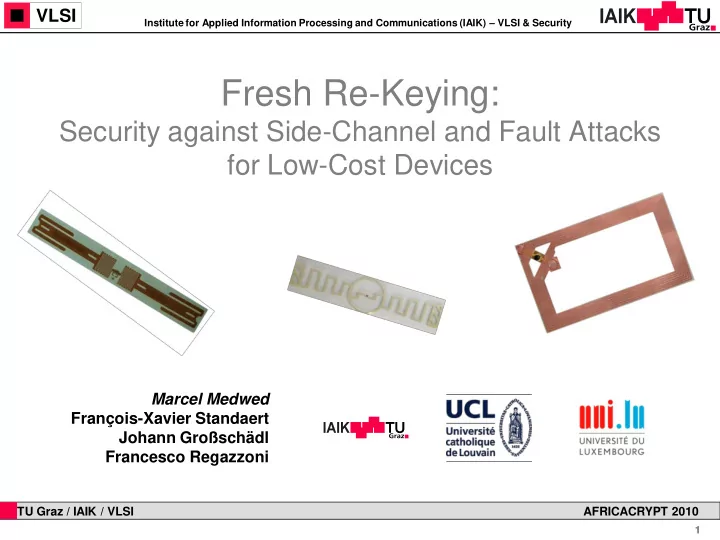

VLSI Institute for Applied Information Processing and Communications (IAIK) – VLSI & Security Fresh Re-Keying: Security against Side-Channel and Fault Attacks for Low-Cost Devices Marcel Medwed François-Xavier Standaert Johann Großschädl Francesco Regazzoni http://www.iaik.tugraz.at TU Graz / IAIK / VLSI TU Graz / IAIK / VLSI AFRICACRYPT 2010 AFRICACRYPT 2010 1 1
Implementation Attacks Fresh Re-keying Hardware Architecture Security Analysis Further research and Conclusions
Attack S imple D ifferential D ifferential P ower P ower F ault A nalysis A nalysis A nalysis # Invocations One or few power 10s - 100s power 2+ encryptions traces traces under the same key and plaintext Extract Hamming Exhaustively Reduce key Goals weights of recover sub-keys entropy to allow (In symmetric setup) intermediate exhaustive search values Uses… Profiling and good Divide-and- knowledge about conquer approach implementation and statistics
Input m Output { c,r } f k* is e.g. AES with session key g k (r) does the re-keying Just shift the problem to g k (r) ? Yes, but g k (r) will be easy to protect
P1: Diffusion P2: No need for synchronization P3: No additional key material P4: Little hardware overhead P5: Easy to protect against SCA P6: Regularity k * = Hash k (r) k * = k xor r k * = k * r (mod GF(2 8 )[y]/y 16 +1)
Implementation Attacks Fresh Re-keying Hardware Architecture Shuffling Secure Logic Blinding Post synthesis results Security Analysis Further research and Conclusions
r 2 r 1 r 0 k 2 k 1 k 0 r 2 k 0 r 1 k 0 r 0 k 0 r 1 k 1 r 0 k 1 r 2 k 1 r 0 k 2 r 2 k 2 r 1 k 2 * k 2 k 1* k 0 *
Use randomized, redundant representation of data Addition and multiplication are distributive k * = k * r = (k+b) * r + b * r Allows arbitrary blinding order
25 20 Area (kGE) 15 g+AES g-pMAC+AES 10 pAES AES 5 0 0 1 2 3 Blinding order
Implementation Attacks Fresh Re-keying Hardware Architecture Security Analysis Choice of k Security against DFA Component-wise Security (SPA and DPA) Security of the Complete Scheme (D&C) Further research and Conclusions
Not every ring element is a unit Choosing a multiple of (y+1) leads to a reduced session-key space Accounts for a loss of entropy of 0.0056 bits out of 128
DFA needs 2+ encryptions under the same key Re-keying thus provides a solid protection
SPA and DPA against g Blinding Shuffling Secure Logic An adversary might get Hamming weights of result digits with unknown indices SPA on AES Shuffling
One bit of k * depends on HW( r ) bits of k #bits for hypothesis usually >1 #traces for attack usually >1 #bits in total
Observe traces with HW( r ) less equal 15 Need to record ~ n t* 2 44 traces
Observe traces with HW( r ) less equal 15 Need to record ~ n t* 2 44 traces Set n t =5 and n g =1 2 60 Hypotheses
Implementation Attacks Fresh Re-keying Hardware Architecture Security Analysis Further research and Conclusions Algebraic Side-Channel Attacks The best Choice for g Two parties
g has a simple structure Thus ASCA is likely to apply Shuffling thwarts basic ASCA Topic is recent, needs further investigation
We picked g since it fulfills the minimum requirements There might be better choices Randomness extractors?
How to extend the scheme to two parties Restrict the choice of r Does coding theory help?
Fresh re-keying separates the system in an SCA target and a cryptanalysis target SCA target generates session key, is small and is easy to protect Complete solution is more efficient than previous proposals (area and security) Only one party can be protected Lots of further research…
VLSI Institute for Applied Information Processing and Communications (IAIK) – VLSI & Security Fresh Re-Keying: Security against Side-Channel and Fault Attacks for Low-Cost Devices Marcel Medwed François-Xavier Standaert Johann Großschädl Francesco Regazzoni http://www.iaik.tugraz.at TU Graz / IAIK / VLSI TU Graz / IAIK / VLSI AFRICACRYPT 2010 AFRICACRYPT 2010 28 28
Recommend
More recommend